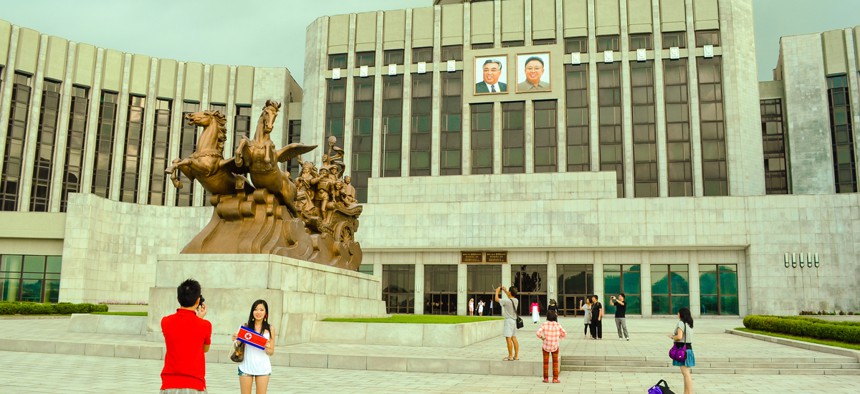North Korea and the Risks of Miscalculation
As tensions rise in East Asia, they highlight the dangers of Trump’s unpredictability.
Not long after the United States Navy dispatched a carrier strike group in the direction of the Korean peninsula following a North Korean missile test last week, Pyongyang vowed to counter “the reckless act of aggression” and hinted at “catastrophic consequences.” The remarks came amid rising tension in the region as satellite images seem to indicate that North Korea is preparing for a possible sixth nuclear test, and as U.S. President Donald Trump warns that North Korean President Kim Jong Un is “doing the wrong thing” and that “we have the best military people on earth.”
There’s nothing particularly unusual about this sort of creative, bellicose rhetoric from the North Korean regime, which routinely threatens to do things like turn Seoul into a “sea of fire” or fire “nuclear-armed missiles at the White House and the Pentagon—the sources of all evil.” North Korea needs to be taken seriously as a hostile regime in artillery range of a close U.S. ally, and potentially in missile range of another. But its leadership lobs threats so promiscuously and outlandishly that one can build in a discount factor—there’s a long track record of unrealized North Korean threats to judge by. In that context, the probability that any given one will be realized is quite small.
The regime has never much liked the annual joint U.S.-South Korea military exercises, and has made its feelings known; the exercises have tended to carry on every year without direct consequences to the personnel involved. Nor has the regime ever welcomed American aircraft carriers in its nearby waters or been shy about saying so; those, too, have come and gone unmolested.
What’s different now is Donald Trump. Whereas many of his predecessors steered sedulously clear of escalatory rhetoric, preferring to treat various North Korean leaders as recalcitrant children at worst or distasteful but nevertheless semi-rational negotiating partners at best, Trump has threatened North Korea via Twitter, declaring that the regime is “looking for trouble.” As my colleague Uri Friedman pointed out Thursday, three successive presidents prior to Trump, since the Clinton administration considered military action against the North’s then-nascent nuclear program, have opted for trying negotiations rather than risk a strike. It’s apparent that none succeeded in halting the nuclear program’s progress. But it’s equally apparent that the kind of massive conflagration on the Korean peninsula that world leaders are now warning against has been avoided since 1953.
For allies, enemies, and observers alike, though, Trump appears to be a wild card, and self-avowedly so. Even foreign-policy positions that are “predictable” for an American president—condemning the use of chemical weapons in war, say, or not deriding NATO as obsolete—were unanticipated reversals from this particular president. Trump himself has said that America needs to be more “unpredictable;” as Kevin Sullivan and Karen Tumulty reported in The Washington Post this week, he has made it so, leaving diplomats to ask what exactly the White House intends to do on issues ranging from border-adjustment taxes to Russia. (Russians are themselves confused: A foreign ministry spokeswoman told my colleague Julia Ioffe and other journalists this week: “We don’t understand what they’re going to do in Syria, and not only there. ... No one understands what they’re going to do with Iran, no one understands what they’re going to do with Afghanistan. Excuse me, and I still haven’t said anything about Iraq.”)
On the other hand, where coercive diplomacy is concerned, there are clear advantages to a posture of: “Don’t try it. You have no idea what I’m capable of.”From Cold War deterrence resting on the guarantee of “mutual assured destruction”—you hit me with nukes, I will strike back, even if we incinerate the world—to Barack Obama’s vow to take unspecified measures against Russian hacking “at a time and place of our own choosing,” presidents routinely court risks and instrumentalize uncertainty as a negotiating tactic. If you extract a concession because an enemy fears an attack you had no real intention of carrying out anyway, so much the better. At the very least, there’s the practical advantage that comes with not telegraphing your intentions to an enemy trying to prepare for your next move.
Yet it’s also the case that uncertainty raises the risks of miscalculation on either side—and, in a tense confrontation between two nuclear powers, the potential costs. Threats of preventive strikes, or even leaks that such strikes could be under consideration, can prompt the other side to want to strike first. There’s a reason that, when NBC reported Thursday based on intelligence sources that the U.S. was prepared to implement exactly such an option, senior officials from the Pentagon quickly disavowed the story and declared it “extremely dangerous.” There’s a reason that the Chinese foreign minister is urging “all sides to no longer engage in mutual provocation and threats, whether through words or deeds, and [not to] push the situation to the point where it can’t be turned around and gets out of hand.” Even the most predictable of leaders must make decisions about each other’s likely actions, and have imperfect information even with the best intelligence, and act on those educated guesses. When two leaders each habitually bluster and exaggerate, there’s a higher likelihood of making a catastrophic mistake based on a bad guess.
This is the case even though the underlying circumstances that could prompt escalation are not terribly dangerous in and of themselves. If North Korea conducts a nuclear test this weekend, it would be its sixth, meaning that its program is advancing but is not necessarily much more dangerous than it was a week ago. There may not even be a test: reporters told to plan for a “big” event in the country on Friday were ushered to the unveiling of a new road and apartment complex. As Anna Fifield writes in The Washington Post, “Expectations for a nuclear test or missile launch in the lead-up to Saturday’s celebrations in Pyongyang have not come to pass. Instead, there are signs that the regime is getting ready to hold a huge parade this weekend, perhaps showing off new missiles—something that would qualify as the ‘big’ event it had heralded.” Even if a nuclear test does materialize, the likelihood of U.S. retaliation is low. The Associated Press reported Friday afternoon that, following a two-month review of its North Korea strategy, the Trump administration had chosen a strategy of “maximum pressure and engagement,” involving “increasing pressure on Pyongyang with the help of China, North Korea's dominant trade and military partner.” (The shape of the “engagement” part is so far unclear; Secretary of State Rex Tillerson has rejected the negotiation option, though this administration is nothing if not flexible.)
In the end, the risks may prove self-mitigating by virtue of their enormity. The Korea expert Victor Cha recently warned Friedman about the possibility of “millions of casualties” resulting from war in the Korean peninsula, if North Korea launched nuclear or conventional strikes against South Korea and Japan. The international-relations scholar Robert Jervis, who has written extensively on deterrence and the Cold War, recently told me that “there were a number of times the Cold War looked desperate and the worst never occurred” and that “deterrence, as a basic feeling, is a powerful inhibitor.” Assuming that logic holds, North Korea will at the very least reap a propaganda payoff just from demonstrating its ability to stoke anxieties around the world with a few coy comments about something “big” in the days before a national holiday. Maybe that’s all they’re after.






